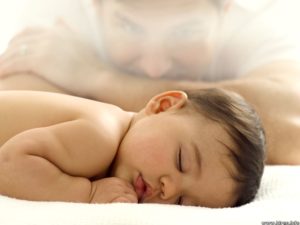Safe Co-Sleeping with an Infant

A sweet dad watching his sleeping baby.
As new parents, it is important to know all about safety and safe sleep.
Safe general sleep information for all infants can be found here. All bottle-fed babies should always follow those guidelines. However, some educated breastfeeding parents choose to bed-share.
Adults’ beds are not designed for infant safety. Therefore, so in order to safely co-sleep both parents need to be in agreement and take responsibility for co-sleeping and infant awareness. A sleeping infant needs an adult to assume responsibility, so co-sleeping with another child or pet is not recommended.
The co-sleeping parent(s) should be free of medications or drugs, as well as alcohol or any substances that affect their ability to wake up. Another risk to be an area of; avoid co-sleeping if you are extremely obese and may not be able to feel the infant around you. Do not co-sleep with clothing that has belts or long strings. Braid long hair and anchor it securely. Avoid anything in the bed that could get trapped around the infant’s neck. Make sure there are no gaps between the bed, frame, and the wall where an infant could get stuck.
These and other ideas for safe sleep can be found at https://cosleeping.nd.edu. Professor James J. McKenna’s Mother-Baby Behavioral Sleep Laboratory studies how sleeping environments reflect and respond to family needs—in particular how they affect mothers, breastfeeding, and infants’ physiological and psychological well-being and development.
(Extracted from the website listed above).
Other resources which may interest you include:
https://www.sleephelp.org/co-sleeping/
https://www.sleephelp.org/pregnancy-sleep-help/
